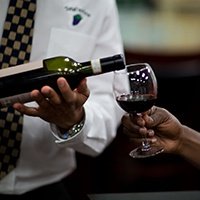St.-Émilion is the star of Bordeaux’s Right Bank, north of the Dordogne River. The rich red wines produced in St.-Émilion, based on Merlot and Cabernet Franc, are less tannic and generally more fruit-driven in flavor than the Cabernet-based wines of Left Bank. Merlot thrives on the plateaus high above the Dordogne, where the soil is filled with sand and clay, a perfect medium for creating opulent, fruit-forward wines. With a typically savory character, St.-Émilion wines are sometimes called the “Burgundies of Bordeaux.” These refined reds, with loads of finesse, are elegant companions to beef, chicken, pork and duck.
The wines of St.-Émilion were not included in the famous 1855 classification of Bordeaux, which ranked wines of the Left Bank. In 1955, St.-Émilion published its own classification, based on soil analysis, wine quality and reputation of the properties. Unlike the 1855 classification, St.-Emilion’s system requires properties to continuously prove themselves. The list is revised regularly, most recently in 2012. There are two tiers within the classification, Premier Grand Cru Classé and Grand Cru Classé. There are currently just 18 Premier Grand Cru properties and 64 Grand Cru Classé properties.
The St.-Émilion appellation is home to hundreds of individual producers, enhancing the variety of wines made there. Many of the properties remain small, family-run enterprises, unlike the large châteaux of the Left Bank. The area is also the base of France’s controversial micro-châteaux or garagiste wine movement; these innovative winemakers operate outside the traditional classification system, making very high quality (and very expensive) highly extracted wines.
The Satellites of St.-Émilion
In 1936, when regulators defined the winegrowing appellation of St.-Émilion, producers in neighboring areas that fell outside the new region obtained permission to append the name of St.-Émilion to their communes, or villages. Today these “satellite” regions are Lussac, Puisseguin, Montagne and St.-Georges. Wines from the St.- Émilion satellites represent excellent value: The soils are similar to those of St.-Émilion and neighboring Pomerol, and identical grapes are planted and used.
Explore France's wine regions
Explore other wine countries and regions
Pronunciation
[San-tay-MEE-lee-yawn]


